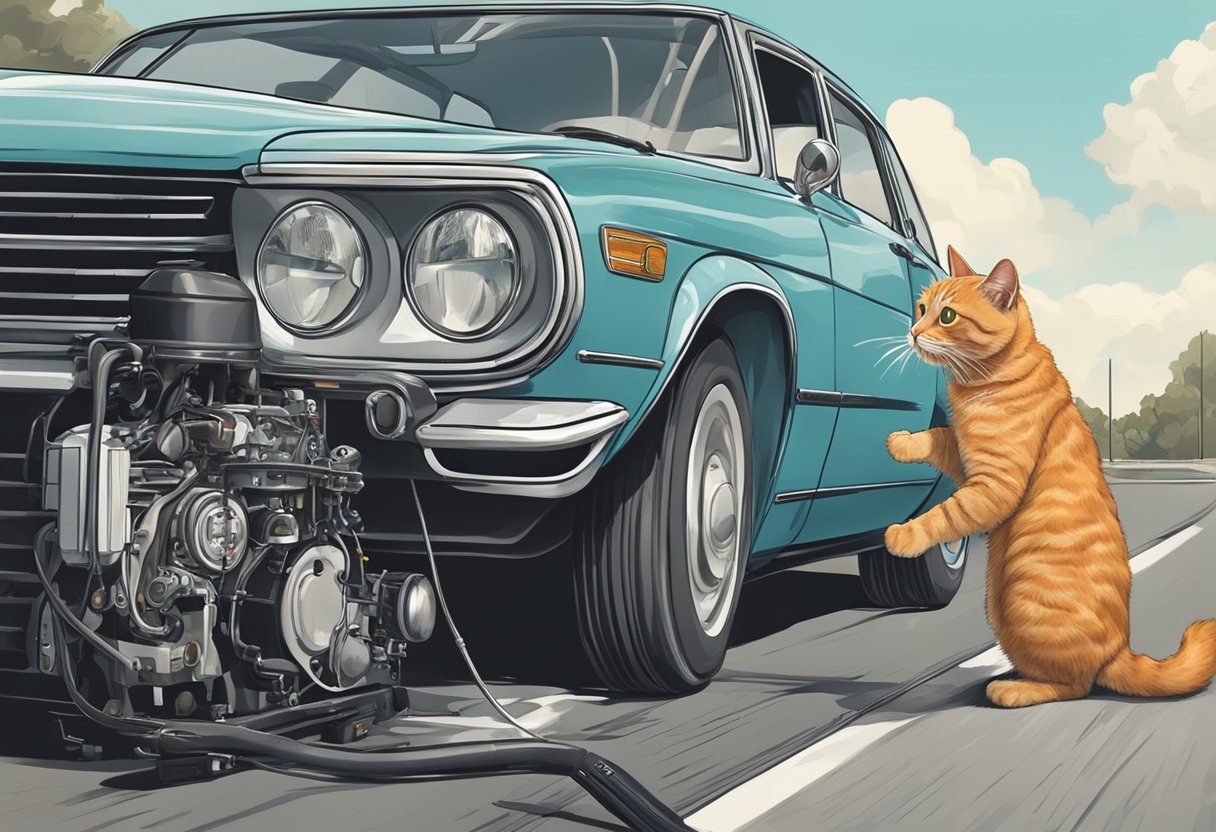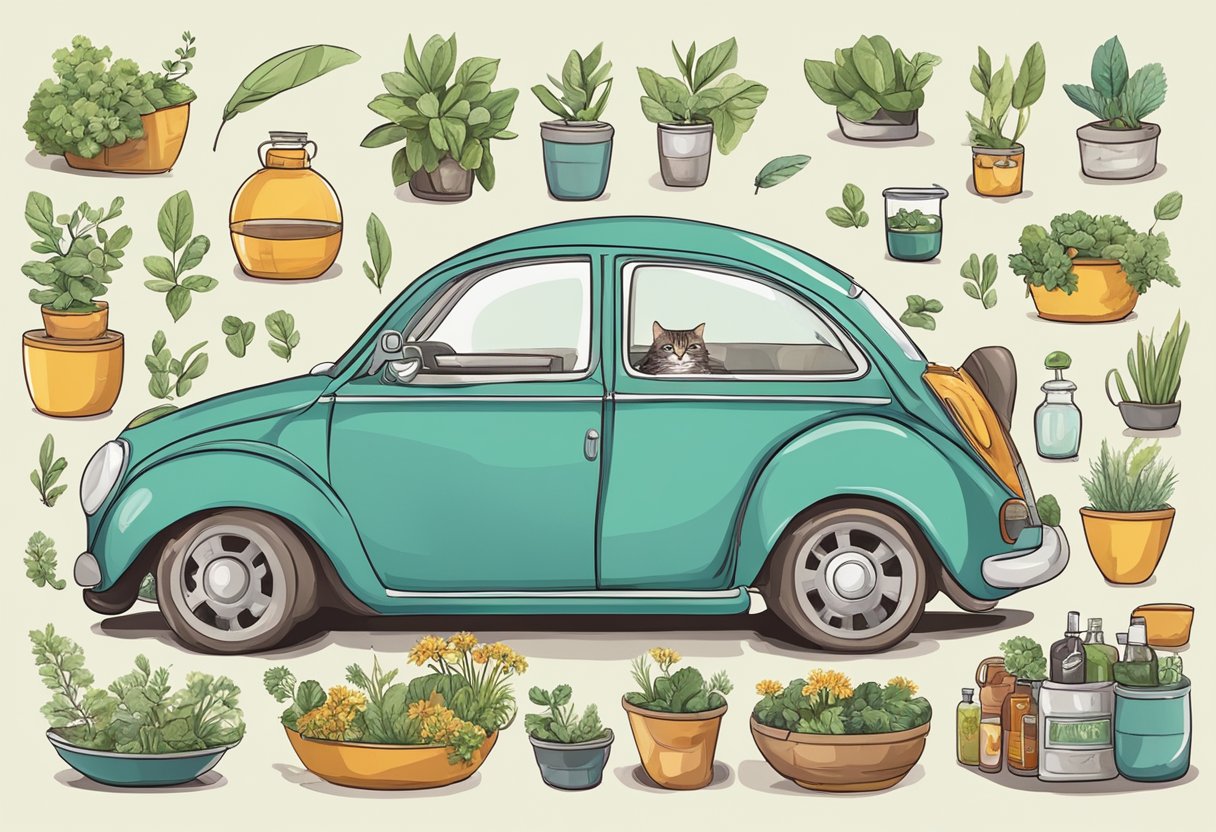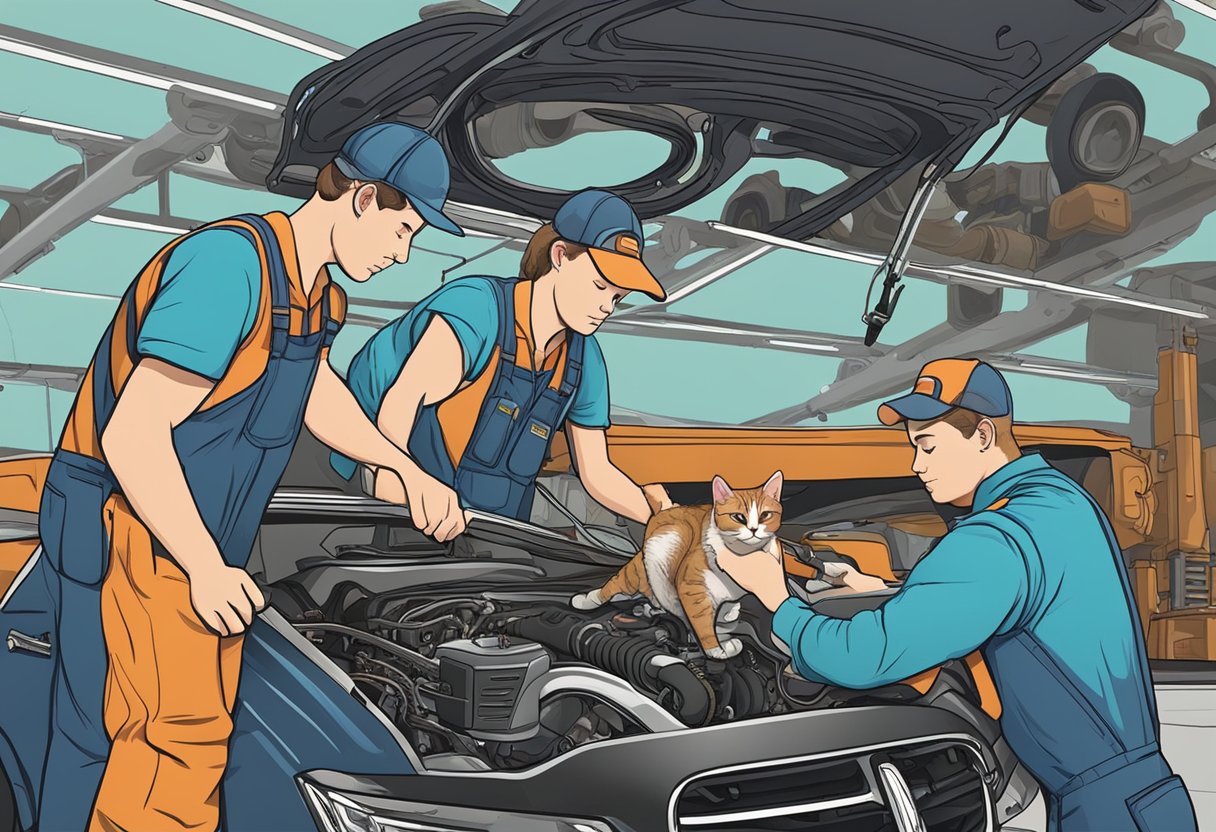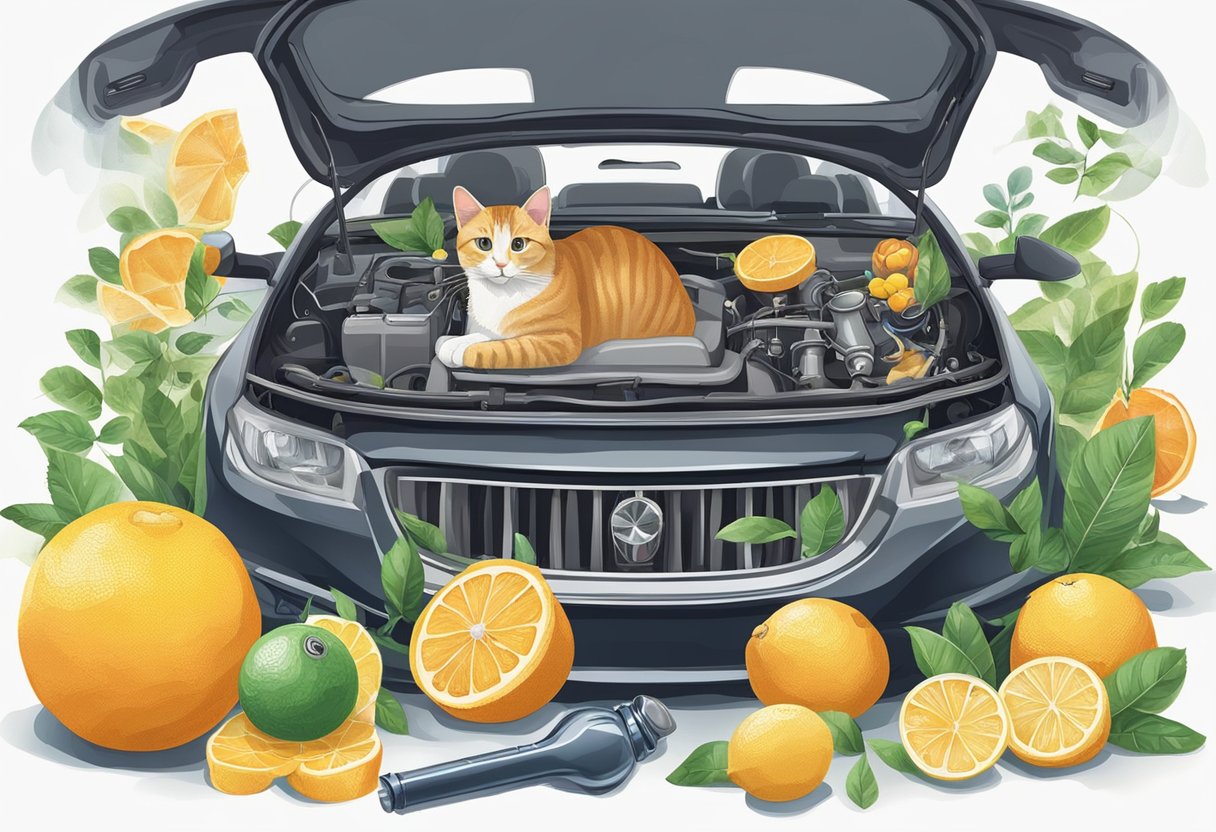As the weather turns colder, cats often seek out warm places to curl up and sleep. One unexpected spot they might choose is beneath the hood of your car, close to the engine which retains heat for hours after it’s been turned off. This behavior, while understandable from the cat’s perspective, can lead to dangerous situations for both the feline and the vehicle owner. Ensuring your car is not an inviting place for cats requires understanding their behavior and implementing effective deterrent strategies.

Owners can employ various methods to discourage cats from seeking refuge in their car engines. Strategies range from simple behavioral deterrents to installing physical barriers. It’s important to remember that while protecting your car, you also want to ensure the safety of any animal that might come into close contact with the vehicle. With proper implementation of preventative measures and a little knowledge of feline habits, owners can successfully keep cats away from their cars.
Key Takeaways
- Cars offer a warm refuge for cats, potentially leading to dangerous situations.
- A combination of deterrents and physical barriers can prevent cats from seeking shelter in car engines.
- Ensuring animal safety while protecting your vehicle requires an understanding of cat behavior and consistent application of preventative strategies.
Understanding Cat Behavior

Cats seek out car engines for their warmth and security. This behavior can be perplexing to some, but understanding it is key to keeping cats safe.
Why Do Cats Hide in Car Engines
Cats, especially stray cats and kittens, are drawn to car engines due to the heat these spaces retain. Often after a vehicle is turned off, the engine remains warm for a considerable time. This residual heat is appealing to cats as they have a high preference for warm places to nap and conserve body temperature, which is particularly true in cold conditions. Cats also have a strong instinct for safety and may perceive the concealed, enclosed space of a car engine as a secure spot to hide from predators.
Temperature and Safety Seeking
Seeking warm spaces is both a comfort preference and a survival tactic for cats. Body temperature regulation is a significant aspect of feline behavior, thus cold outdoor temperatures drive them to find heat wherever possible. Safety is another priority for cats; enclosed spaces give a sense of security, which is why car engines can be particularly attractive. Car engines present a dual appeal: safeguarding from the elements and potential threats, as well as a snug place for a nap.
Preventive Measures to Protect Cats and Engines

Ensuring the safety of both cats and car engines requires specific strategies to deter curious felines from finding a hazardous haven under the hood of a vehicle.
Securing the Garage
A garage not only shelters a vehicle but can also attract feline visitors seeking warmth. To prevent cats from entering, one should ensure that the garage doors are consistently closed. Garage maintenance checks for any gaps or openings are crucial, as cats can squeeze through surprisingly small spaces. If a garage is not available, one might consider parking in other enclosed areas to mitigate the risk.
Car Covers and Their Benefits
A car cover serves as a physical barrier that can discourage cats from climbing onto the vehicle. High-quality car covers fit snugly, leave no loose fabric for cats to claw or pull, and may lessen the warmth emitted from an engine, making it less enticing for a cat. The use of a tarp, though not as form-fitting as a car cover, can also serve as a deterrent when secured properly around the vehicle.
Using Repellents Effectively
Cat repellent sprays contain odors that are unappealing to cats but are typically non-toxic and humane. These can be applied around the vehicle, concentrating on the tires and garage perimeter. Alternatives include natural deterrents like cayenne pepper, which can create an invisible barrier cats are likely to avoid. It’s important to reapply these repellents regularly, as their effectiveness can diminish due to weather conditions or wear.
Behavioral Deterrents and Discouragement
To effectively deter cats from entering car engines, it is essential to understand and employ behavioral deterrents. These methods disrupt the habits of cats by creating an environment that is less appealing or more startling for them.
Sound Alarms and Alerts
Car alarms, when triggered, emit a loud noise that can frighten cats away from vehicles. Setting a car alarm to be sensitive enough to detect motion can prevent a cat from settling in the engine bay. Similarly, one can honk the horn before starting the car to warn any nearby cats. This act can serve as a consistent warning signal, discouraging cats from approaching the vehicle in the future.
Spray Bottles and Sprinkler Systems
Spray bottles are a straightforward tool in discouraging cats. By spraying water near the vehicle when a cat approaches, they learn to associate the area with an undesirable experience. For a more automated approach, sprinkler systems can be employed. Installing motion-activated sprinklers near the parking area can startle cats with a burst of water, conditioning them to avoid the vicinity of the car.
Natural Remedies and Home Solutions

Protecting your car engine from curious cats can be done effectively using natural remedies. These non-toxic solutions harness the power of aromatic herbs and homemade mixes to deter felines safely.
Herbs and Aromatic Deterrents
Cats typically avoid strong scents, which makes certain herbs and spices excellent deterrents. Sprinkling cayenne pepper around the car can prevent cats from approaching, as they find the smell irritating. Similarly, lavender and rosemary are pleasant to humans but can act as natural repellents due to their potent aroma. Planting these herbs near your parking area or placing dry herbs under the hood can help keep cats at bay.
Homemade Repellent Mixtures
Many homeowners find success in crafting homemade repellent mixtures. A common recipe includes mixing water with vinegar and a few drops of essential oils, such as eucalyptus or lavender. Another mixture might involve blending lemon juice, rosemary, and cayenne pepper into a spray. It’s crucial to apply these homemade repellents regularly, as their effectiveness can diminish over time. Homemade sprays are a cost-effective and environmentally friendly alternative to commercial cat repellent sprays. Remember, although mothballs can deter cats due to their strong smell, they contain chemicals that can be harmful to both cats and humans, thereby not recommended for use.
Physical Barriers and Safety Measures

To effectively prevent cats from entering car engines, a combination of physical barriers and routine safety checks is essential. These precautions can deter cats and ensure their safety as well as protect the vehicle from damage.
Implementing Car Barriers
It is crucial to establish defensive measures to discourage feline intrusion into the engine bay. One of the most effective methods is utilizing car covers, which serve as a physical shield making access to the vehicle more challenging for cats. Not only do these covers offer protection against animals, but they also safeguard the car from environmental elements.
- Use fitted car covers to form a barrier against cats
- Ensure the cover snugly fits around the vehicle, leaving no openings
Routine Pre-Drive Checks
Incorporating a series of routine pre-drive checks can significantly reduce the risk of cat-related incidents. Before starting the engine, one should safely honk the horn or bang on the hood to scare away any cats that may have sought refuge or warmth near the engine.
- Always visually inspect the area around and under the vehicle
- Tap loudly on the hood several times to alert any hiding cats
By adhering to these actions consistently, drivers can foster a safer environment for both cats and their vehicle.
Handling Stray and Outdoor Cats

Dealing with stray and outdoor cats requires a proactive approach. It is important to focus on community involvement and fostering an understanding of humane methods for keeping cats away from vehicles.
Community Involvement and Education
Community effort is key to managing the presence of strays near cars. Members can help by informing their neighbors about the risks associated with cats hiding in car engines, sharing simple methods to deter them such as using car covers or deterrent sprays. Additionally, organizing community-led discussions about humane cat deterrents benefits the protection of these animals while also safeguarding the community’s vehicles.
Adoption and Rescue Information
For those stray cats that are friendly and approachable, engaging with local rescue organizations provides these animals with the chance for adoption into a caring home. Distribution of rescue information via flyers or social media can also increase the likelihood of strays finding companionship and reduce the number of homeless animals in the neighborhood.
Long-Term Strategies and Considerations
When seeking long-term solutions for keeping cats out of car engines, it is essential to consider both the human patterns, such as parking behaviors, and cat behaviors, particularly their environment preferences.
Parking Locations and Patterns
Where one parks can significantly influence the likelihood of cats taking refuge in a car engine. Consistently parking in a secure garage, where possible, reduces the access cats have to the vehicle, effectively minimizing the risk. For those who must park outdoors, selecting well-lit areas away from shrubbery can deter cats. Additionally, varying parking spots disrupts patterns that cats may become accustomed to, thus reducing the odds of them using the car as shelter.
Promoting Indoor Environments for Cats
Encouraging an indoor lifestyle for cats in the community contributes to their safety and deters them from seeking shelter in cars. Providing resources or support for local trap-neuter-return (TNR) programs helps manage stray populations responsibly. As weather turns harsh, informing neighbors about the benefits of keeping their cats indoors not only keeps the pets warm but also prevents them from curling up in car engines for warmth.
Additional Tips and Methods

To safeguard your vehicle’s engine from feline intruders or other small animals, proactive strategies are essential. Regular check-ups can discourage these unwanted visitors, and understanding your coverage ensures you’re prepared for any damage they might cause.
Regular Maintenance to Deter Animals
Regular Vehicle Checks: Conducting routine inspections of the vehicle’s engine compartment can help detect the presence of animals before they cause trouble. Drivers should look for signs of nesting or chewing on wires.
- Cleanliness: Ensure that the engine area is free from debris and food scraps, as these can attract animals. A clean and uncluttered engine is less inviting to cats and other pests.
- Engine Covers: Using a fitted engine cover when the vehicle is parked can help deter animals from climbing inside.
Understanding Insurance and Damage
Documenting Damage: If one discovers scratches or other damage caused by animals, it’s crucial to document the damage with photos and to contact their insurance company promptly.
- Insurance Policies: Vehicle owners should review their policies to understand what is covered. Some might find it helpful to consider add-on coverage like Embrace Pet Insurance for comprehensive protection against animal damage.
Frequently Asked Questions
In this section, readers will find targeted advice on strategies to prevent cats from accessing their car engines and how to humanely discourage these behaviors.
What methods work effectively for deterring cats from climbing into car engines?
One straightforward method is utilizing your car’s horn to scare cats away before starting the engine. Another involves installing physical barriers to restrict access.
What are the best practices for preventing cats from using vehicles as resting places?
It’s advisable to check underneath the car and give the hood a tap before entering. Offering shelter can also divert cats from seeking warmth from a vehicle’s engine.
How can I use a car cover to protect my engine compartment from cats?
Employing a car cover acts as a deterrent by blocking the entrance to the engine area, making it less accessible and attractive for cats looking for a warm hideout.
Which repellents are safe and effective at keeping cats away from my vehicle?
Natural deterrents such as citrus peels or commercial cat repellents that emit sounds or sprays can safeguard your vehicle without harming the animals.
Why do cats gravitate towards car engines and how can this be prevented?
Cats are attracted to the warmth of car engines, especially in colder weather. Regular inspections and providing an alternative warm sleeping area can prevent this behavior.
What are some humane strategies to deter cats from marking their territory on my car?
Maintaining a clean car, using specific cleaners that eliminate odors, and applying safe olfactory deterrents can help prevent cats from scent-marking a vehicle.
